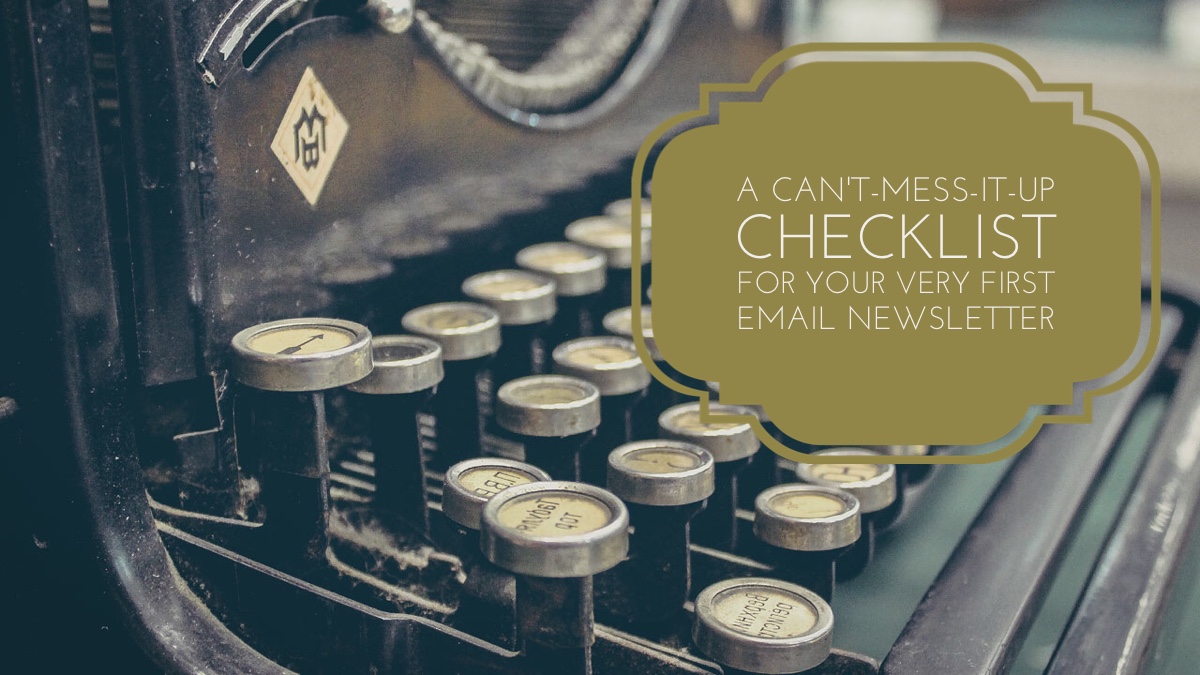Email marketing is the cornerstone of my business. I’ve sent an email newsletter once a month every month since January 2010.
At the time, my months followed the same pattern: I would write a handful of articles per client for a handful of retainer clients, source stock photography to accompany the blog posts, login to my clients’ websites to publish their blogs, login to their email tools and write, test and disseminate their email newsletters.
I was a content generating machine. I could Google “natural remedies for insomnia” faster than most people could located their web browser. The idea of starting my own newsletter was a little tiring, to say the least. But I knew that it worked because I saw how in my clients’ businesses every day.
Here’s my can’t-mess-it-up checklist for sending your very first email newsletter.
1. Keep it personal
Email is intimate. That’s why people can be reluctant to give you their email address in the first place. Getting into someone’s email inbox is a privilege. Don’t squander it with a mass, impersonal address, “Hello Friends!”
Imagine that you’re writing your email to a friend. Regardless of the size and nature of your business, email gives you a fantastic opportunity to humanise your brand and talk about challenges, or even your failures. Several business women who’s emails I subscribe to have revealed surprise job changes, indecisions and uncertainty, divorce and extended procrastination. This makes me feel closer to them. So long as I feel the message they’re delivering is relevant, useful and valuable to me, I feel privileged to be privy to such details. You don’t have to reveal intimate details from your life to have a warm tone-of-voice and be personal.
2. Your subject line is your most important sentence
Too often, email newsletter subject lines are treated as an afterthought. This is the single most important line in your entire email. Your subject line and your sender reputation are the two most influential factors when people are scanning their inboxs and deciding what to open and read, overlook or delete. You have no sender reputation (yet!) so make sure your subject line is compelling, memorable or provocative. Don’t just summarise your newsletter and call it a headline – it’s not.
3. Give your value centre stage
Every single marketing piece you put out into the world should be given with value, usefulness and relevance for the end user in mind. This is doubly so for your email newsletter.
People will stay on your list because you’re lighting up their day, inspiring them with smart ideas, boosting their mood and giving them valuable information that they can implement to be happier, healthier, less stressed and more productive. Regardless of whether you blog, vlog, or podcast, your content needs to take centre stage.
4. Brevity is polite
You don’t need to include every single thing that’s coming up in your business. The most effective way to communicate is with brevity. By all means, go link-crazy, summarising upcoming events, courses or other happenings and linking to them. But resist the temptation to overstuff your email. The more you include, the less likely it will be read.
5. Use images
Visual marketing is on the rise, and it’s no wonder. We’re a visually-oriented society. We’re taking pictures, looking at pictures, appearing in pictures, sharing pictures, and watching pictures. Ensure you have large (but low-resolution), quality, and relevant images to accompany your copy.

6. Spend time on formatting
Make reading a pleasure and people will be far more likely to read. Ensure your headings are bold and distinct. Put enough white space around the different elements so that they are easy on the eye. Resist the temptation to do something funky with fonts and font colours. Research shows that using buttons will greatly increase the likelihood that your links will be clicked, rather than using hyperlinked text.
7. Test all links
Hopefully, your email newsletter is filled with links, taking people through to your website, your blog posts, your sales pages. So it’s absolutely essential that these links work. Ensure you send yourself a test before each and every email newsletter is distributed and make sure that you click. Every. Single. Link.
8. Ensure you have all email addresses uploaded
Did you attend a conference, networking event or speak at an event recently? Collate all your email addresses into your list before you send your email newsletter, and ensure you do this each and every time before hitting ‘send’.
9. Remind people what you do and where you are
Every single email you send should remind people what you do. This shouldn’t take up more than a sentence. This doesn’t have to be the same sentence – in fact, this is a great opportunity to refine your elevator pitch. If you have a physical premises, include your address in the footer of every email. Even if you have an online business, geography gives your readers context. If you want to encourage phone calls, include your phone number in your header image.
10. Don’t be boring
All tips can be whittled down to this – boring is poison to your marketing. It should be penalised – the business owner who refuses to consider the snore-inducing affects of their marketing should be forced to endure 24 hours straight of infomercials while eating some dull breakfast cereal such as Weet-bix. People will stay on your list, open your emails, and read them because you add something to their days. Remember, time is the one commodity we can’t get more of. People spending their precious time and attention on your emails is a privilege that you need to take seriously.





